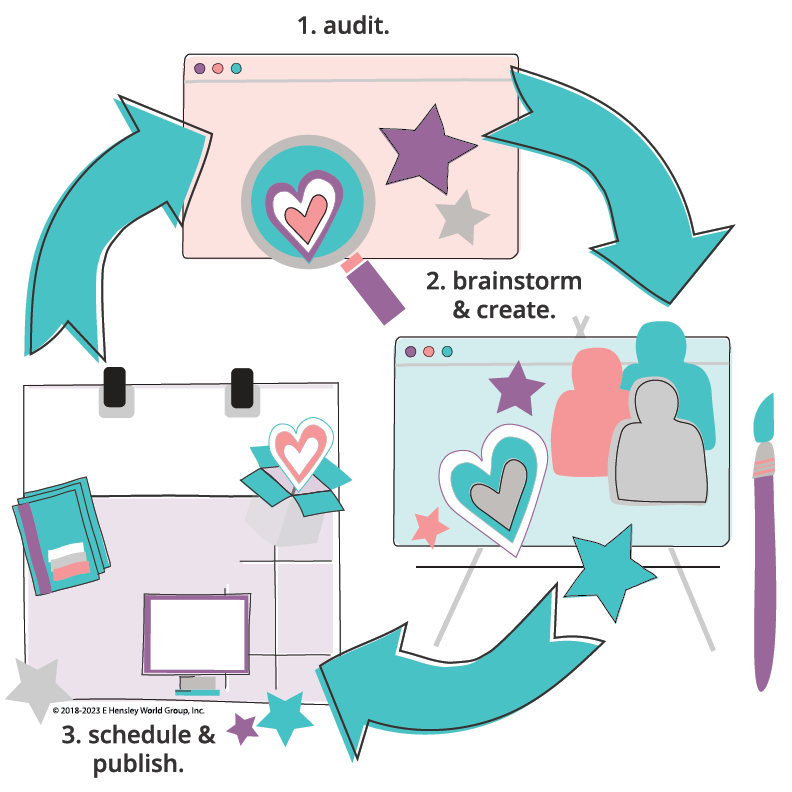digital marketing overview.
Our people-first, data-informed digital marketing strategy starts and ends with your website.
Why? Because at some point in every customer’s decision process (also known as the customer decision journey or CDJ), they will visit your website.
Let’s take a step back for a minute. When we say digital marketing, we are talking about any online marketing initiative.
We ask upfront about your business goals because your available budget and timeframe for results determine whether your digital marketing strategy will be:
primarily outbound (when an individual identified by either your Marketing or Sales team visits your website as a result of something they did, for example, an email, a retargeted ad),
a mix of outbound and inbound (when an individual initiates the visit to your website),
or solely inbound.
Whether you decide on inbound marketing, outbound marketing, or a mix, all of our content strategy and demand generation recommendations will drive your target audience to your website where they’ll be encouraged to raise their hand and opt-in to learn more.
We want:
first-time inbound visitors to register for an offer so that we can add them to your CRM, qualify, and follow up with targeted content that moves them through the CDJ.
as many of our targeted outbound contacts to reply to our Sales outreach, automatically adding our sales rep to their allow list; click through a URL to claim an offer, moving from a non-marketing contact to a marketing contact; or, if they go directly to our website, to register for an offer, updating their CRM record from a non-marketing contact to a marketing contact.
for both inbound visitors and outbound contacts a digital footprint that tells you how they got to your website (organic search, referral, outbound Sales outreach, or other channel), what they did or didn’t do (pages visited, content downloaded, videos watched, and so on), and how many actions over what period of time they took before buying.
marketing operations
Your people, processes, and technology–your marketing operations–are crucial to the success of your marketing strategy. They’ll influence whether your business goals are possible on your budget and within your time frame.
We want to know:
your martech stack;
the people responsible for setting up and sending out your outbound campaigns, for creating and/or updating your dashboards, for measuring the effectiveness of your campaigns, and more;
and the processes around handoffs between Marketing and Sales, the speed with which visitors or leads are followed up with.
Most importantly, we want historical data on the actions taken by your inbound visitors and targeted outbound contacts to date. This data gives us an idea of which content will support your goals. For example, if you’re not getting enough website traffic, and you need so many eBook downloads to close a sale, just offering an eBook on your website—no matter how good the content—won’t give you the results you’re looking for.
content strategy
Before you begin creating content, you need to know how you’ll use it. Your content strategy is your plan for what content you’ll supply at which points along the CDJ to meet your user goals and reach your business goals.
At its simplest a content strategy has three phases:
AUDIT. In this first phase, you want to discover what content exists and what is/isn’t working and to map out the best days/times and channels on which to publish content. At the end of your audit, you’ll know where the holes are and have a prioritized list of content to update or create.
BRAINSTORM AND CREATE. At this stage, you’ll involve a mix of people across your organization: subject matter experts, Sales and Customer Success, and potentially customers. Getting everyone aligned increases the likelihood your final content achieves your business goals while addressing your users’ tasks.
SCHEDULE AND PUBLISH. Finally, you’ll decide when you’ll release your content and where, what your plan for tracking and measuring success is, and how you’ll iterate if your content doesn’t perform as anticipated.
demand generation
Put simply, demand generation is how you leverage your content strategy to educate your target audience about what you do (awareness), get them excited (interest/consideration/evaluation), and generate revenue (purchase). Demand generation can be either inbound or outbound depending on where along the CDJ you focus moving from the creation of demand (awareness) to its capture (purchase).
Inbound demand generation is initiated by your leads and customers, for example, organic search, organic social, and referrals. You create content to organically attract and engage your target audience, but whether they will and when they do is out of your control.
Outbound demand generation is initiated by you, for example, paid search, paid social, targeted ads, promotions, and sales outreach to potential leads with high purchase intent.





